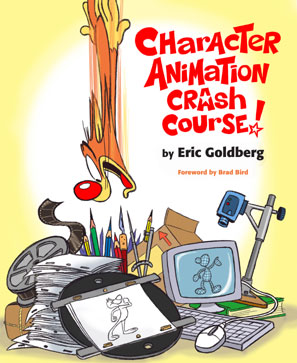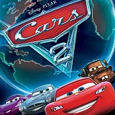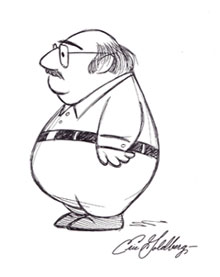 Recently, master Disney and Warner Bros. animator (as well as animation director and producer and voice artist!) Eric Goldberg spoke with Animated News & Views about his recent book release, Character Animation Crash Course, which has been gestating in production for some two-and-a-half decades.
Recently, master Disney and Warner Bros. animator (as well as animation director and producer and voice artist!) Eric Goldberg spoke with Animated News & Views about his recent book release, Character Animation Crash Course, which has been gestating in production for some two-and-a-half decades.
A contemporary animation legend, Eric has animated on films including Raggedy Ann and Andy, Ziggy’s Gift (both for Richard Williams), Aladdin, Hercules, Fantasia/2000 and Pocahontas (which he also co-directed) for Disney, and was director of animation on Looney Tunes: Back In Action at Warners.
He has also completed a number of special animation projects, for a Buddhist cultural center (A Monkey’s Tale), and Disney theme parks in Tokyo (Genie in the Magic Lamp Theater), Anaheim (the Disneyland 50th Anniversary special with Steve Martin and Donald Duck) and Orlando (The Gran Fiesta Tour starring The Three Caballeros).
Most recently back at Disney as an animator on Goofy’s return to shorts in How To Hook Up Your Home Theater, Eric is currently the Supervising Animator on the Michael Leon Wooley-voiced character of Louis the alligator in the Studio’s traditionally animated feature The Princess And The Frog, set for release in 2009.
Due to the inclusion of a CD that highlights in video form the techniques that Eric writes about in the book, Character Animation Crash Course earns the notable distinction of being the first animator’s guide to actually feature real animation in it. In this interview, Eric talks about how the book originally came to be and gives some insightful thoughts on animation in general.
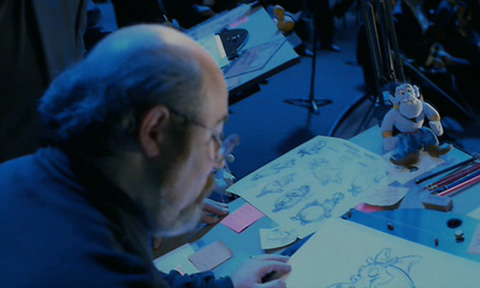
Animated Views: Character Animation Crash Course started out as informal notes you had been taking, which were (as the book makes mention) passed around from aspiring animator to aspiring animator and seen almost as the holy grail of animation notes. That must have been flattering, but when did you first get the idea that it could evolve into an official book?
Eric Goldberg: The notes really started life as a series of once-a-week lectures for up and coming animators at my London studio, Pizazz Pictures. I put a lot of time and effort into them, and in fact always had video clips on hand from classic cartoons to illustrate the points. Once I realized that the notes were being passed around by the animation folks in London, and that I had amassed a fair stack of them, it was obvious that they might be informative to others on a larger scale. That said, the book idea became a little more pressing when I discovered that people were using the notes to teach their college animation courses, posting them on the net, and plagiarizing them wholesale while claiming them as their own. My wife Susan, ever my cheerleader, saw to it that I plodded ahead, and with her encouragement, I completed the task in a mere twenty-five years. I frankly never had any problem with animators passing the stuff around and Xeroxing it, and am flattered still if someone tells me the notes were instrumental in their animation education.

AV: Is there material in the book that’s not in the notes?
EG: There is quite a lot of new material in the book that has been especially created for it, including new subjects like animating to music, as well as more depth and new drawings for the ones that started in the original notes. The notes themselves continually evolve too, and several lectures and pages were created in response to demand for certain subjects during my time at Disney, and they have all been included here. Last but not least, the CD of animation movie files that illustrates the text was wholly created for the book, a longtime dream of mine to include the actual animation for people to examine in real time or frame-by-frame.
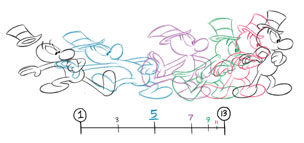
AV: Character Animation Crash Course is filled with helpful knowledge about animating, but at what point do you say, “Okay, I’ve placed enough knowledge in this particular book”, and save any other thoughts for a future publication?
EG: At no point in creating the book did I say to myself, “Well, I’ll hold back on this info for the sequel; this’ll keep the little stinkers happy for a while.” In fact, quite the opposite was true: once the text was complete, and I was finishing the art and the movie files, I would frequently pause for a “D’oh! I forgot to include this! D’oh! I should have expanded on that!” I hope to have a new book of D’ohs some time in the future.

AV: How did Silman-James Press become your publisher?
EG: At a book fair a few years ago, Stuart and Amy Ng mentioned to their friend Tom Rusch, of Silman-James Press, that I had been working on this animation book for quite some time, and would they be interested in publishing it? Tom got in touch and hooked me up with Gwen Feldman, publisher extraordinaire, and we came to a speedy agreement. What wasn’t speedy was how much longer she had to wait for it, but thank goodness she’s a patient soul!

AV: How did Brad Bird land the job of writing the foreword? If Bird had not written it, who would have?
EG: I’ve known Brad for many years, and he’s always been very nice about me in print, so I thought at least he might actually think some of those nice things he says. At the last Annie Awards, I collared him about the possibility of writing it for me. He graciously put his forklift (the one carrying all of his awards that evening) into neutral, and agreed, for which I am eternally in his debt. There was only one other candidate for the part, but unfortunately I was too late in completing the book. Before he passed away, Chuck Jones had offered to write it.
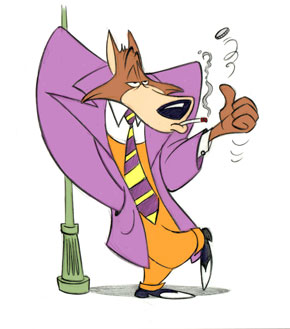
AV: Was there anything you wished to include in the book or on the CD that you couldn’t due to copyright laws?
EG: Well, if I had oodles of money and phalanxes of lawyers to acquire rights for me, I would have loved to include video clips of every cartoon I reference in the book, as well as the complete freedom to draw any character I felt like regardless of who owns it. As it is, I’m very grateful to Disney for allowing me generous usage of the Genie, Phil, The Snotty Six, and lots of other characters that required their permission.
AV: During your time at Disney, you’ve worked under the management of Jeffrey Katzenberg, Tom Schumacher and John Lasseter – all but David Stainton. Could you compare and contrast how it was working for each of those people?
EG: They were all marvelous. I never worked for David Stainton, but he was marvelous too. And you forgot Peter Schneider. Also marvelous. And John Lasseter is currently marvelous, and will be for years to come.
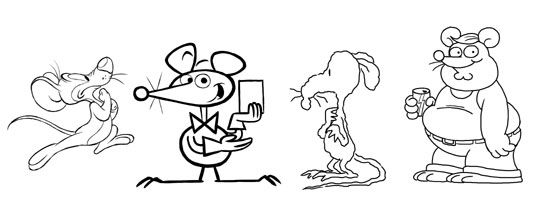
AV: What can you say regarding your work on The Princess And The Frog?
EG: I’m having fun. More info to come when the time is deemed right by the wise publicity mavens at Disney.
AV: Are you animating the title sequence for The Pink Panther 2, since you animated the previous film’s titles?
EG: Nope.
AV: Why does Wikipedia state that you are “the director of Pirates Of The Caribbean, a cartoon based on one of the Disney attractions”?
EG: Because somebody at Wikipedia really, really, really wanted me to have done it, and he made it so!

AV: After 30-plus years in the animation business, what are some things you know now that contradict beliefs you had during your first years working in animation?
EG: When I first started animating, I did everything straight-ahead, having trained myself primarily on flip books. During my first years at Richard Williams, I slowly, painfully, made the transition to working with keys and breakdowns, saw my work stiffen up, and then learned just how instrumental it was to planning your animation to do what you wanted it to. Also, I used to believe in the Easter Bunny, and now I don’t.
AV: What is the greatest accomplishment for an animator? Likewise, what is the greatest failure?
EG: I think the greatest accomplishment for an animator is to have created a character that doesn’t look like you created it – that the behavior, the movement, the expressions, the timing, the nuances all come from the character himself, fully formed. I think the greatest failure for an animator is not to aim for that every time out.

AV: How do you feel about the future of hand-drawn techniques as animation shifts to paperless production using Cintiq tablets in place of traditional animation discs and drawing in programs like TVP Animation, which has the ability to simulate the texture of pencil and watercolors, or ToonBoom Harmony? Are these types of software getting close enough to the look and feel of traditional techniques or do you think pencil on paper still has the advantage for full, classical character animation?
EG: I actually don’t have a problem with the notion of paperless animation, and I’ve been comfortable on a Wacom Cintiq since 2002 on Looney Tunes: Back in Action, where I used it for pose drawings, and subsequently comping them over the live-action takes for creative approvals. I use it a lot in storyboarding and design work, and almost all of the animation tests on the CD, as well as the book’s many illustrations, were drawn that way, even if their origin was as a paper sketch in the original notes. If the program is sophisticated enough to accommodate the subtleties of good classical animation drawing, then I can make use of it. However – nothing replicates the one-on-one, tactile physicality of rolling, flipping, and drawing on paper, and I’ll always consider it the premiere way.
AV: When do you expect you might write a follow-up to Character Animation Crash Course?
EG: I hope to have the next installment out some time in the next twenty-five years. Maybe sooner!
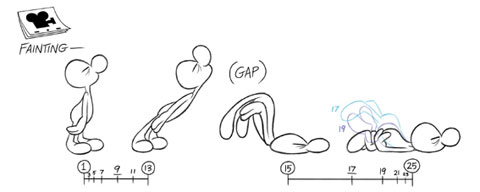
Special thanks go to Eric Goldberg and to Cynthia and Bernie at Silman-James Press for facilitating this interview.
For more on Eric Goldberg’s work, including A Monkey’s Tale, read our previous conversation with him here!
Visit Disney’s official The Princess And The Frog site here!


